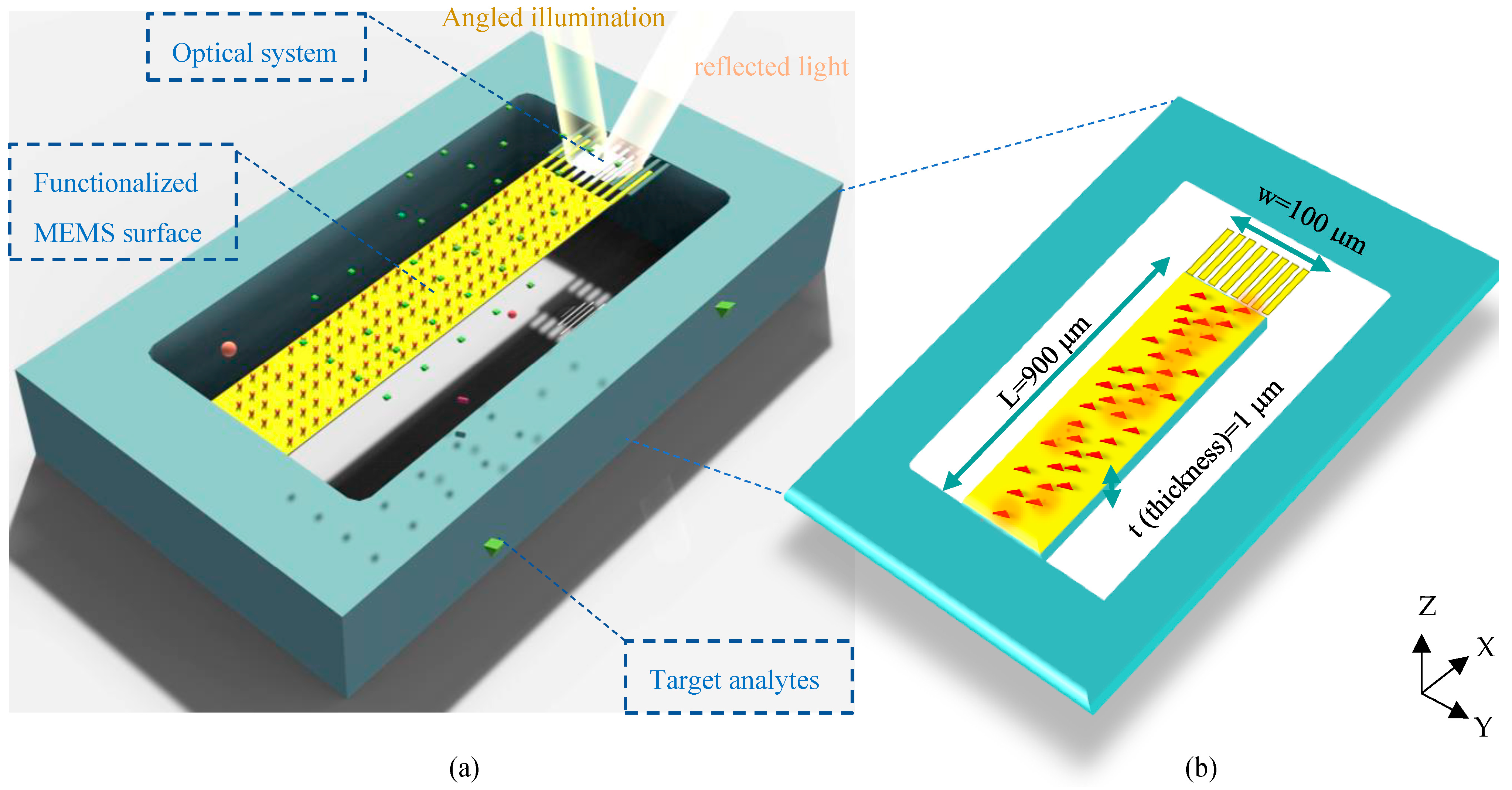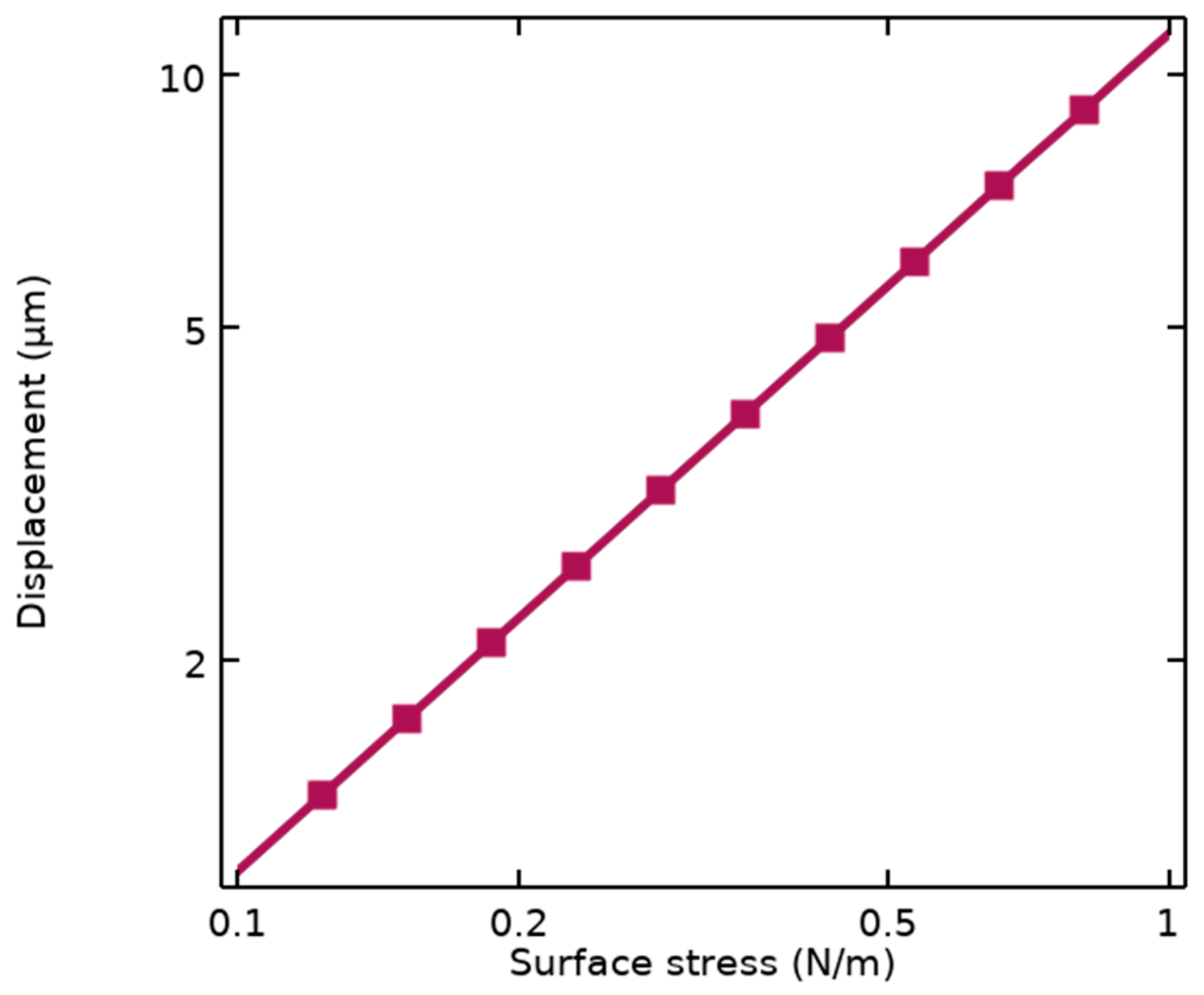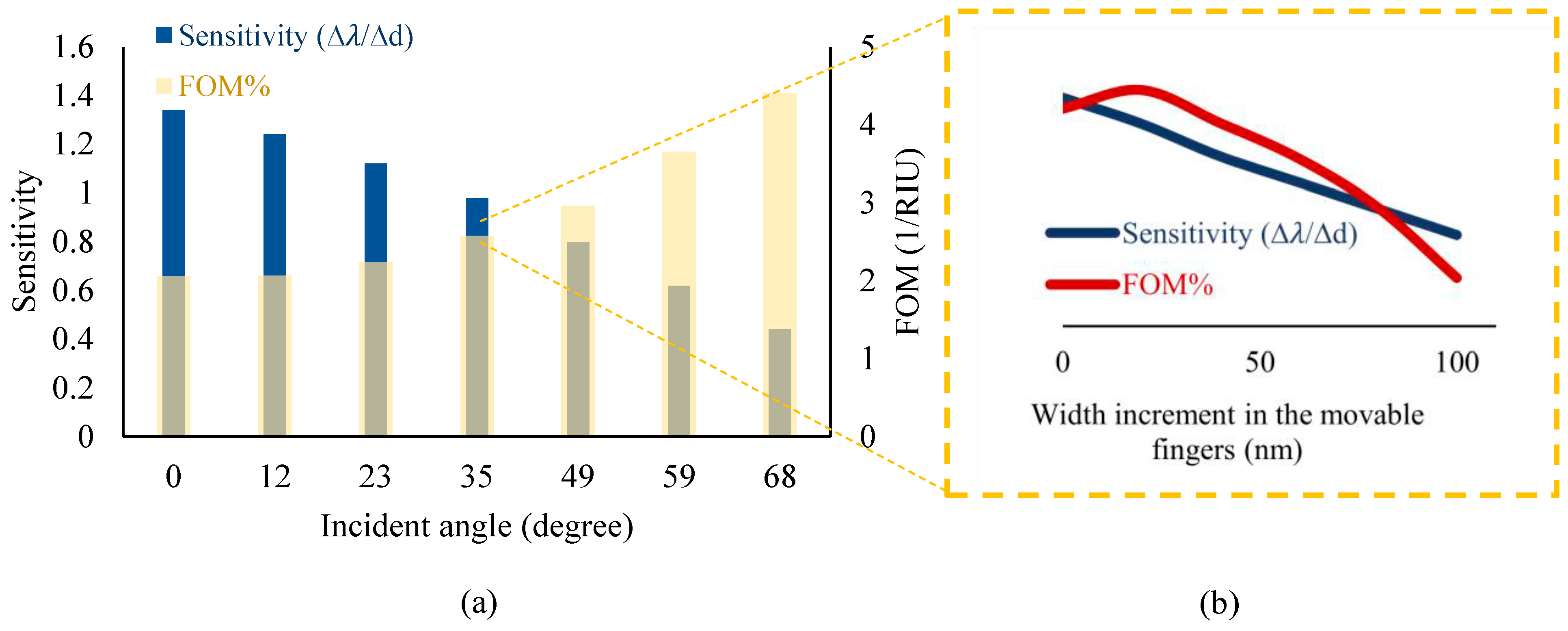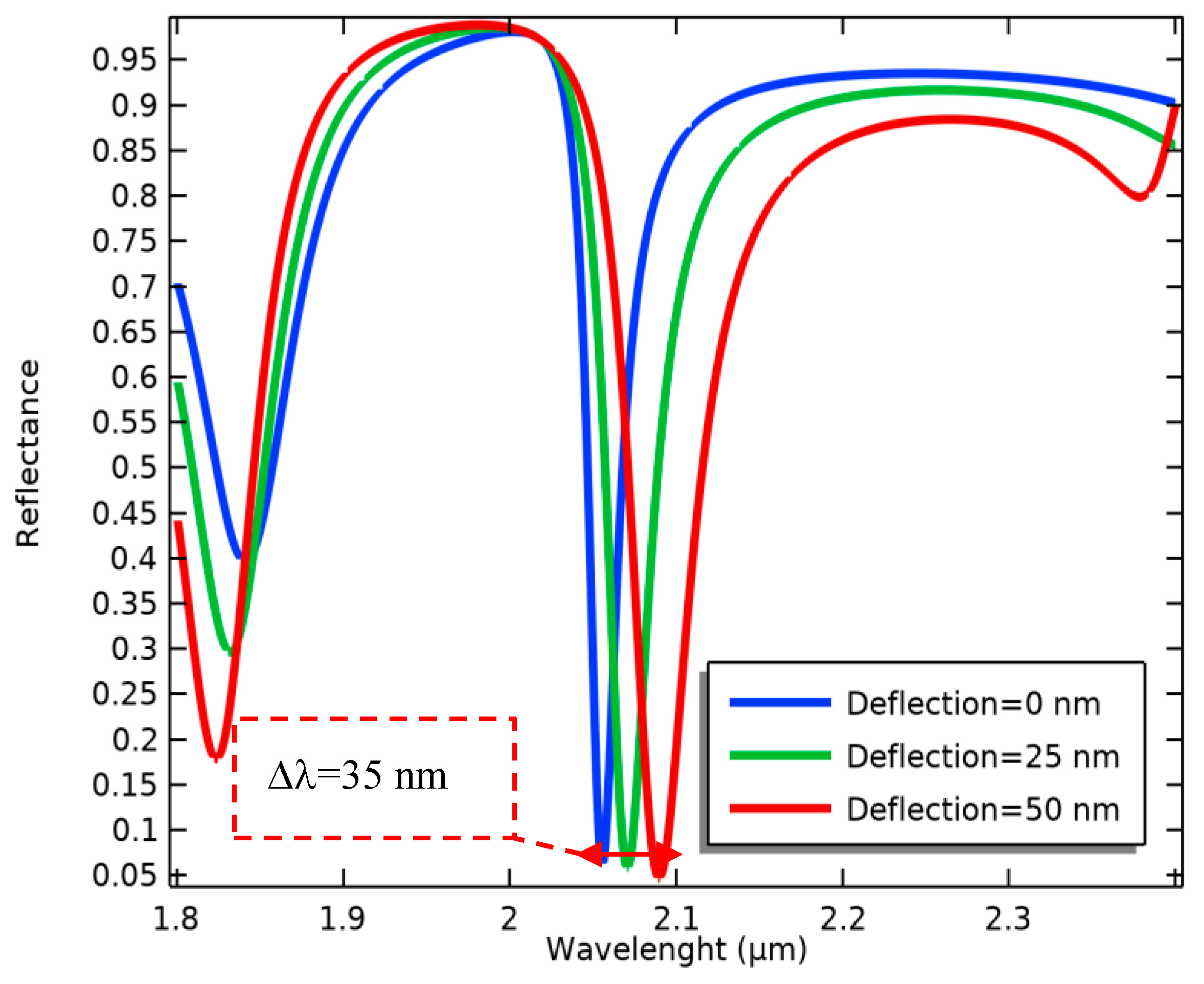Grating Bio-Microelectromechanical Platform Architecture for Multiple Biomarker Detection
Abstract
1. Introduction
2. Operating Principles of the Proposed Optical MEMS Biosensor
2.1. MEMS Analysis
2.2. Mechanism of the Optical System
2.3. Multiple Biomarker Detection
3. Comparative Study
4. Conclusions
Author Contributions
Funding
Data Availability Statement
Conflicts of Interest
References
- Ansah, J.P.; Chiu, C.T. Projecting the chronic disease burden among the adult population in the United States using a multi-state population model. Front. Public Health 2022, 10, 1082183. [Google Scholar] [CrossRef] [PubMed]
- Yuan, X.; Chen, S.; Sun, C.; Yuwen, L. A novel early diagnostic framework for chronic diseases with class imbalance. Sci. Rep. 2022, 12, 8614. [Google Scholar] [CrossRef] [PubMed]
- Marvi, F.; Jafari, K.; Shahabadi, M.; Tabarzad, M.; Ghorbani-Bidkorpeh, F.; Azad, T. Ultrasensitive detection of vital biomolecules based on a multi-purpose BioMEMS for Point of care testing: Digoxin measurement as a case study. Sci. Rep. 2024, 14, 1633. [Google Scholar] [CrossRef] [PubMed]
- Ebrahimi, G.; Samadi Pakchin, P.; Shamloo, A.; Mota, A.; de la Guardia, M.; Omidian, H.; Omidi, Y. Label-free electrochemical microfluidic biosensors: Futuristic point-of-care analytical devices for monitoring diseases. Microchim. Acta 2022, 189, 252. [Google Scholar] [CrossRef]
- Lin, T.-Z.; Chen, C.-H.; Lei, Y.-P.; Huang, C.-S. Gradient Guided-Mode Resonance Biosensor with Smartphone Readout. Biosensors 2023, 13, 1006. [Google Scholar] [CrossRef] [PubMed]
- Altug, H.; Oh, S.-H.; Maier, S.A.; Homola, J. Advances and applications of nanophotonic biosensors. Nat. Nanotechnol. 2022, 17, 5–16. [Google Scholar] [CrossRef] [PubMed]
- Chadha, U.; Bhardwaj, P.; Agarwal, R.; Rawat, P.; Agarwal, R.; Gupta, I.; Panjwani, M.; Singh, S.; Ahuja, C.; Selvaraj, S.K.; et al. Recent progress and growth in biosensors technology: A critical review. J. Ind. Eng. Chem. 2022, 109, 21–51. [Google Scholar] [CrossRef]
- Nava, G.; Zanchetta, G.; Giavazzi, F.; Buscaglia, M. Label-free optical biosensors in the pandemic era. Nanophotonics 2022, 11, 4159–4181. [Google Scholar] [CrossRef]
- Wang, M.; Yang, Y.; Min, J.; Song, Y.; Tu, J.; Mukasa, D.; Ye, C.; Xu, C.; Heflin, N.; McCune, J.S.; et al. A wearable electrochemical biosensor for the monitoring of metabolites and nutrients. Nat. Biomed. Eng. 2022, 6, 1225–1235. [Google Scholar] [CrossRef]
- Wu, J.; Liu, H.; Chen, W.; Ma, B.; Ju, H. Device integration of electrochemical biosensors. Nat. Rev. Bioeng. 2023, 1, 346–360. [Google Scholar] [CrossRef]
- Chieng, A.; Wan, Z.; Wang, S. Recent Advances in Real-Time Label-Free Detection of Small Molecules. Biosensors 2024, 14, 80. [Google Scholar] [CrossRef]
- Chen, C.; Wang, J. Optical biosensors: An exhaustive and comprehensive review. Analyst 2020, 145, 1605–1628. [Google Scholar] [CrossRef]
- Liu, J.; Wachsmann-Hogiu, S. Progress and Challenges of Point-of-Need Photonic Biosensors for the Diagnosis of COVID-19 Infections and Immunity. Biosensors 2022, 12, 678. [Google Scholar] [CrossRef]
- Wu, Y.; Feng, J.; Hu, G.; Zhang, E.; Yu, H.-H. Colorimetric Sensors for Chemical and Biological Sensing Applications. Sensors 2023, 23, 2749. [Google Scholar] [CrossRef] [PubMed]
- Lee, S.M.; Lee, S.; Lee, S.H.; Ahn, G.R.; Lee, B.Y.; Kim, S.H.; Song, M.; Chung, W.J. Engineered M13 bacteriophage-enhanced colorimetric detection of allergenic fungi. Sens. Actuators B Chem. 2023, 393, 134244. [Google Scholar] [CrossRef]
- Yang, J.; Wang, X.; Sun, Y.; Chen, B.; Hu, F.; Guo, C.; Yang, T. Recent Advances in Colorimetric Sensors Based on Gold Nanoparticles for Pathogen Detection. Biosensors 2023, 13, 29. [Google Scholar] [CrossRef]
- Chircov, C.; Grumezescu, A.M. Microelectromechanical Systems (MEMS) for Biomedical Applications. Micromachines 2022, 13, 164. [Google Scholar] [CrossRef] [PubMed]
- Lim, H.J.; Saha, T.; Tey, B.T.; Tan, W.S.; Ooi, C.W. Quartz crystal microbalance-based biosensors as rapid diagnostic devices for infectious diseases. Biosens. Bioelectron. 2020, 168, 112513. [Google Scholar] [CrossRef]
- Johnson, B.N.; Mutharasan, R. Biosensing using dynamic-mode cantilever sensors: A review. Biosens. Bioelectron. 2012, 32, 1–18. [Google Scholar] [CrossRef] [PubMed]
- Basu, A.K.; Basu, A.; Bhattacharya, S. Micro/Nano fabricated cantilever based biosensor platform: A review and recent progress. Enzym. Microb. Technol. 2020, 139, 109558. [Google Scholar] [CrossRef] [PubMed]
- Sang, S.; Zhao, Y.; Zhang, W.; Li, P.; Hu, J.; Li, G. Surface stress-based biosensors. Biosens. Bioelectron. 2014, 51, 124–135. [Google Scholar] [CrossRef] [PubMed]
- Zhao, D.; Liu, Y.; Zhang, Q.; Zhang, Y.; Zhang, W.; Duan, Q.; Yuan, Z.; Zhang, R.; Sang, S. Surface stress-based biosensor with stable conductive AuNPs network for biomolecules detection. Appl. Surf. Sci. 2019, 491, 443–450. [Google Scholar] [CrossRef]
- Mathew, R.; Ravi Sankar, A. A Review on Surface Stress-Based Miniaturized Piezoresistive SU-8 Polymeric Cantilever Sensors. Nano-Micro Lett. 2018, 10, 35. [Google Scholar] [CrossRef] [PubMed]
- Han, X.; Huang, M.; Wu, Z.; Gao, Y.; Xia, Y.; Yang, P.; Fan, S.; Lu, X.; Yang, X.; Liang, L.; et al. Advances in high-performance MEMS pressure sensors: Design, fabrication, and packaging. Microsyst. Nanoeng. 2023, 9, 156. [Google Scholar] [CrossRef] [PubMed]
- Liu, Y.; Tian, Y.; Lin, C.; Miao, J.; Yu, X. A monolithically integrated microcantilever biosensor based on partially depleted SOI CMOS technology. Microsyst. Nanoeng. 2023, 9, 60. [Google Scholar] [CrossRef] [PubMed]
- Álvarez, M.; Carrascosa, L.G.; Zinoviev, K.; Plaza, J.A.; Lechuga, L.M. Biosensors Based on Cantilevers. In Biosensors and Biodetection: Methods and Protocols: Electrochemical and Mechanical Detectors, Lateral Flow and Ligands for Biosensors; Rasooly, A., Herold, K.E., Eds.; Humana Press: Totowa, NJ, USA, 2009; pp. 51–71. [Google Scholar]
- Marvi, F.; Jafari, K. A Biosensing Platform Based on Metamaterials BioNEMS for Lab-on-Chip Systems. IEEE Trans. Nanobiosci. 2024, 23, 11–17. [Google Scholar] [CrossRef] [PubMed]
- Marvi, F.; Jafari, K. A Novel Photonic Crystal BioNEMS Sensing Platform Based on Fano resonances. J. Light. Technol. 2021, 39, 7296–7302. [Google Scholar] [CrossRef]
- Marvi, F.; Jafari, K. A Novel BioNEMS Sensor Based on Tunable Plasmonic Modes of a Grating MIM Structure. IEEE J. Sel. Top. Quantum Electron. 2023, 29, 6900108. [Google Scholar] [CrossRef]
- Sbeah, Z.A.; Adhikari, R.; Sorathiya, V.; Chauhan, D.; Rashed, A.N.Z.; Chang, S.H.; Dwivedi, R.P. GST-Based Plasmonic Biosensor for Hemoglobin and Urine Detection. Plasmonics 2022, 17, 2391–2404. [Google Scholar] [CrossRef]
- Chorsi, H.T.; Lee, Y.; Alù, A.; Zhang, J.X.J. Tunable plasmonic substrates with ultrahigh Q-factor resonances. Sci. Rep. 2017, 7, 15985. [Google Scholar] [CrossRef]
- Miyan, H.; Agrahari, R.; Gowre, S.K.; Mahto, M.; Jain, P.K. Computational Study of a Compact and High Sensitive Photonic Crystal for Cancer Cells Detection. IEEE Sens. J. 2022, 22, 3298–3305. [Google Scholar] [CrossRef]









| Q-Factor | Sensor Sensitivity (μm/Nm−1) | Optical Sensitivity | Mechanical Sensitivity (μm/Nm−1) | Biosensor |
|---|---|---|---|---|
| 3078 | 0.2 | 0.2 | 1.05 | [28] |
| 80 | 0.6 | 0.5 | 1.2 | [29] |
| 102.7 | 8.08 | 0.7 | 11.55 | This work |
Disclaimer/Publisher’s Note: The statements, opinions and data contained in all publications are solely those of the individual author(s) and contributor(s) and not of MDPI and/or the editor(s). MDPI and/or the editor(s) disclaim responsibility for any injury to people or property resulting from any ideas, methods, instructions or products referred to in the content. |
© 2024 by the authors. Licensee MDPI, Basel, Switzerland. This article is an open access article distributed under the terms and conditions of the Creative Commons Attribution (CC BY) license (https://creativecommons.org/licenses/by/4.0/).
Share and Cite
Marvi, F.; Jafari, K.; Sawan, M. Grating Bio-Microelectromechanical Platform Architecture for Multiple Biomarker Detection. Biosensors 2024, 14, 385. https://doi.org/10.3390/bios14080385
Marvi F, Jafari K, Sawan M. Grating Bio-Microelectromechanical Platform Architecture for Multiple Biomarker Detection. Biosensors. 2024; 14(8):385. https://doi.org/10.3390/bios14080385
Chicago/Turabian StyleMarvi, Fahimeh, Kian Jafari, and Mohamad Sawan. 2024. "Grating Bio-Microelectromechanical Platform Architecture for Multiple Biomarker Detection" Biosensors 14, no. 8: 385. https://doi.org/10.3390/bios14080385
APA StyleMarvi, F., Jafari, K., & Sawan, M. (2024). Grating Bio-Microelectromechanical Platform Architecture for Multiple Biomarker Detection. Biosensors, 14(8), 385. https://doi.org/10.3390/bios14080385






